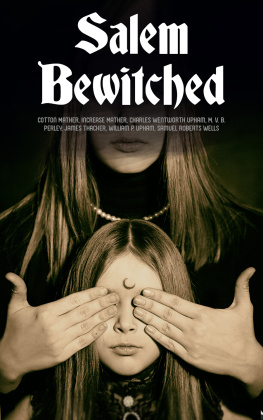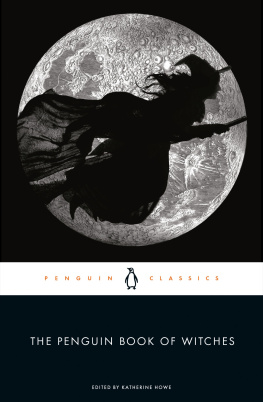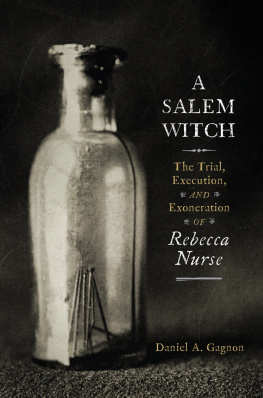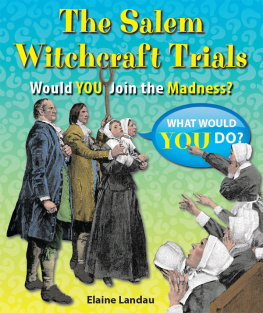AMERICA BEWITCHED
AMERICA BEWITCHED
The story of witchcraft after Salem
OWEN DAVIES



Great Clarendon Street, Oxford, OX2 6DP,
United Kingdom
Oxford University Press is a department of the University of Oxford.
It furthers the Universitys objective of excellence in research, scholarship,
and education by publishing worldwide. Oxford is a registered trade mark of
Oxford University Press in the UK and in certain other countries
Owen Davies 2013
The moral rights of the author have been asserted
First Edition published in 2013
Impression: 1
All rights reserved. No part of this publication may be reproduced, stored in
a retrieval system, or transmitted, in any form or by any means, without the
prior permission in writing of Oxford University Press, or as expressly permitted
by law, by licence or under terms agreed with the appropriate reprographics
rights organization. Enquiries concerning reproduction outside the scope of the
above should be sent to the Rights Department, Oxford University Press, at the
address above
You must not circulate this work in any other form
and you must impose this same condition on any acquirer
British Library Cataloguing in Publication Data
Data available
ISBN 9780199578719
Printed in Great Britain by
Clays Ltd, St Ives plc
Links to third party websites are provided by Oxford in good faith and
for information only. Oxford disclaims any responsibility for the materials
contained in any third party website referenced in this work.
ACKNOWLEDGEMENTS
Thanks once again to the usual suspects, my family and Cline Chantier, for their ongoing support. I have benefited from discussions regarding various aspects of the book with Willem de Blcourt, Francesca Matteoni, and Rowland Hughes. Thanks also to Luciana OFlaherty, H. C. Erik Midelfort, and Ronald Hutton who read through the manuscript and made useful comments and corrections. Matthew Cotton of Oxford University Press provided just the right balance of prodding and patience to get the book finished.
TABLE OF CONTENTS
.
.
.
.
.
.
.
.
.
.
.
.
.
.
.
.
.
.
.

AFTERMATH
N ineteen people executed, one man pressed to death during interrogation, and four others perished in gaol. This was the human toll of the Salem witch trials of 1692. Many more were bereaved and traumatized, and a community was left counting the economic, social, spiritual, and moral costs. It all began with the antics of two young girls, the daughter and niece of Samuel Parris, the minister of Salem Village. Within months over 150 people from twenty-four different towns were being investigated for witchcraft. As historians have shown, though, the development of the Salem witch trials was as much a story of the multiple tensions of a developing colonial community as the result of the terrible lies of adolescent girls and prejudices of the male Puritan authorities.
The Salem trials resulted in the last of the estimated thirty-eight to forty executions for witchcraft recorded in the British colony. Without the Salem toll the record of official persecution of witches in America would have been mild compared with much of Europe. To say Salem was an aberration, though, would be to misrepresent the popular fear and hatred of witches at the time. This did not diminish despite the changing legal response to witchcraft following Salem. After years of petitioning by those who had suffered, on 17 October 1711 the Massachusetts legislature reversed the guilty verdicts of twenty-two of those convicted and paid hundreds of pounds in compensation to their families. The days of the witch trials seemed to be over: its victims now the righteous, and their persecutors the shamed.
Through schooling and the media the events of 1692 are etched into the consciousness of modern America. The date, like 1776 and 1865, brings to a close a chapter in the annals of the countrys development. The end of the Salem trials, and the immediate soul searching in its aftermath, mark the beginning of the American enlightenment. Over the ensuing centuries Salem served as a metaphor for bigotry, intolerance, religious fanaticism, persecution, popular credulity, personal ambition, and the dangers of mob rule. As the decades passed, it was also used as a milepost to measure the distance America had progressed from a benighted colonial past. During the nineteenth century, Remember Salem! became a term of antiquarian abuse, a playground game of name callingOur colonial founders were more level-headed and enlightened than yours! State historians rummaged through the archives and were satisfied to find themselves well down the witch-trial league table. The near absence of witch trials in Connecticut turned its early historians into enthusiastic finger-waggers gesturing in the direction of their northern neighbours.
The cry of Salem! was frequently heard in the rivalry between North and South, a rhetorical weapon used by the latter to attack New Englanders and their perceived sense of superiority over the southern states and their defence of the barbarity of slavery. When a Virginian is in his most unwholesome frame of mind against the Yankees, he is apt to refer, in terms either derisive or denunciatory, to the New England trials and executions for witchcraft, sighed one commentator in 1869. Another, complaining of the censorship laws in Virginia, warned, let her never talk of the hanging of witches by Massachusetts.
Then there was the desire amongst some Massachusetts communities to seek collective forgiveness for a stain on their states history. In 1852 Jonathan Waite, a 54-year-old woollen manufacturer of North Brookfield, presented a petition to the Massachusetts legislature requesting that monuments be erected to those who were executed for witchcraft in Salem. The proposal was not taken up, but the idea was revived in 1875 when the descendants of one of the victims, Rebecca Nourse, met in the New England Genealogical Rooms, Boston, to plan a fundraising campaign for a monument to commemorate her death. The Nourse Monument Association was founded and raised over $520, enough for a monument to be erected in 1885 at the Nourse ancestral home in Danvers (formerly Salem village). An impressive ceremony was held on the 30 July to mark its completion, at which Danvers pastor, the
So, much of the discourse on Salem through the eighteenth and nineteenth centuries assumed that the history of witchcraft ended with Salem. The veil was conveniently drawn and tied fast. This book tears open the veil and reveals a very different story. The Salem nineteen were the last to be legally executed for witchcraft in the colony, yet we now know of more people killed as witches in America after 1692 than before it.
For many in late colonial and independent America, witches remained a real and terrible threat. For them, Salem was not a horrific miscarriage of justice. In 1787 the Philadelphia City Sessions of the Mayors Court heard the case of a woman who died after being brutally treated by a mob who accused her of witchcraft. Five years later a German woman, aged around seventy, was one of four people who were subjected to violent popular justice in Fairfield County, South Carolina, under suspicion of witchcraft. They launched suits against their assaulters in the county court and won nominal damages. With the influx of new immigrants and the ongoing challenges faced by the settled population, the history of witchcraft in America was entering a new and not a final phase.
Next page














